Characterization of Moisture Sources for Austral Seas and Relationship with Sea Ice Concentration
Abstract
:1. Introduction
2. Methodology
2.1. Data and Area of Study
2.2. Lagrangian Approach for Moisture Transport Identification
2.3. Backward Trajectories: Identification of the Moisture Sources for the Southern Ocean Seas
2.4. Forward Trajectories: Main Moisture Sinks in the Southern Ocean Seas
2.5. Moisture Sink and Sea Ice Concentration
3. Results
3.1. Main Features of the Moisture Sources
Backward Analysis: Identification of Moisture Sources for the Southern Ocean Seas
3.2. Forward Analysis: Relationships Between the Moisture Sink and the SIC
3.3. Extremes in the Moisture Sink for the Weddell Sea and the SIC
4. Conclusions
Author Contributions
Funding
Acknowledgments
Conflicts of Interest
References
- Sea Ice Atlas. Available online: http://seaiceatlas.snap.uaf.edu/glossary (accessed on 13 August 2017).
- Hartmann, D. Global Physical Climatology, 2nd ed.; Elsevier Science: Amsterdam, The Netherlands, 2015; ISBN 9780080918624. [Google Scholar]
- Fletcher, J.O. Ice Extent on the Southern Ocean and Its Relation to World Climate; Rand Corporation Research Memorandum RM-5793-NSF; Rand Corporation: Santa Monica, CA, USA, 1969. [Google Scholar]
- Peixoto, J.P.; Oort, A.H. Physics of Climate; American Institute of Physics: New York, NY, USA, 1992. [Google Scholar]
- Strass, V.H.; Fahrbach, E. Temporal and Regional Variation of Sea Ice Draft and Coverage in the Weddell Sea Obtained from Upward Looking Sonars. In Antarctic Sea Ice: Physical Processes, Interactions and Variability; Antarctic Research Series; Elsevier: Amsterdam, The Netherlands, 1998; Volume 74, pp. 123–139. [Google Scholar]
- Parkinson, C.L.; Cavalieri, D.J. Antarctic sea ice variability and trends, 1979–2010. Cryosphere 2012, 6, 871–880. [Google Scholar] [CrossRef]
- Dieckmann, G.S.; Hellmer, H.H. The importance of sea ice: An overview. In Sea Ice, 2nd ed.; Thomas, D.N., Dieckmann, G.S., Eds.; Wiley-Blackwell: Oxford, UK, 2010; pp. 1–22. [Google Scholar]
- Leppäranta, M. The Drift of Sea Ice; Springer: Berlin/Heidelberg, Germany, 2005; 266p. [Google Scholar]
- Renwick, J.A.; Kohout, A.; Dean, S. Atmospheric forcing of Antarctic sea ice on intraseasonal time scales. J. Clim. 2012, 25, 5962–5975. [Google Scholar] [CrossRef]
- Wadhams, P. Ice in the Ocean; Gordon and Breach Science Publishers: Amsterdam, The Netherlands, 2000. [Google Scholar]
- Parkinson, C. A 40-y record reveals gradual Antarctic sea ice increases followed by decreases at rates far exceeding the rates seen in the Arctic. Proc. Natl. Acad. Sci. USA 2019, 116, 14414–14423. [Google Scholar] [CrossRef] [Green Version]
- Meehl, G.A.; Arblaster, J.M.; Chung, C.T.Y.; Holland, M.M.; DuVivier, A.; Thompson, L.; Yang, D.; Bitz, C.M. Sustained ocean changes contributed to sudden Antarctic sea ice retreat in late 2016. Nat. Commun. 2019, 10, 14. [Google Scholar] [CrossRef]
- Hobbs, W.R.; Massom, R.; Stammerjohn, S.; Reid, P.; Williams, G.; Meier, W. A review of recent changes in Southern Ocean sea ice, their drivers and forcings. Glob. Planet. Chang. 2016, 143, 228–250. [Google Scholar] [CrossRef] [Green Version]
- Holland, P.R.; Kwok, R. Wind-driven trends in Antarctic sea-ice drift. Nat. Geosci. 2012, 5, 872–875. [Google Scholar] [CrossRef]
- Comiso, J.C.; Gersten, R.A.; Stock, L.V.; Turner, J.; Perez, G.J.; Cho, K. Positive trend in the Antarctic sea ice cover and associated changes in surface temperature. J. Clim. 2017, 30, 2251–2267. [Google Scholar] [CrossRef]
- Turner, J.; Comiso, J. Solve Antarctica’s sea-ice puzzle. Nature 2017, 547, 275–277. [Google Scholar] [CrossRef]
- Weeks, W.F. On Sea Ice; University of Alaska Press: College, AK, USA, 2010; 664p. [Google Scholar]
- Raphael, M.N.; Hobbs, W. The influence of the large-scale atmospheric circulation on Antarctic sea ice during ice advance and retreat seasons. Geophys. Res. Lett. 2014, 41, 5037–5045. [Google Scholar] [CrossRef]
- The Intergovernmental Panel on Climate Change. IPCC Climate Change 2013: The Physical Science Basis; Contribution of Working Group I to the Fifth Assessment Report of the Intergovernmental Panel on Climate Change; Stocker, T.F., Qin, D., Plattner, G.-K., Tignor, M., Allen, S.K., Boschung, J., Nauels, A., Xia, Y., Bex, V., Midgley, P.M., Eds.; Cambridge University Press: Cambridge, UK; New York, NY, USA, 2013; p. 1535. [Google Scholar] [CrossRef]
- De Lavergne, C.; Palter, J.B.; Galbraith, E.D.; Bernardello, R.; Marinov, I. Cessation of deep convection in the open South-ern Ocean under anthropogenic climate change. Nat. Clim. Chang. 2014, 4, 278–282. [Google Scholar] [CrossRef]
- Gordon, A.L. Oceanography: Southern Ocean polynya. News Views Nat. Clim. Chang. 2014, 4, 249–250. [Google Scholar] [CrossRef]
- Thomas, D.N. Sea Ice, 3rd ed.; Wiley-Blackwell: New York, NY, USA, 2017. [Google Scholar] [CrossRef]
- Ionita, M.; Scholz, P.; Grosfeld, K.; Treffeisen, R. Moisture transport and Antarctic sea ice: Austral spring 2016 event. Earth Syst. Dyn. 2018, 9, 939–954. [Google Scholar] [CrossRef]
- Turner, J.; Phillips, T.; Marshall, G.J.; Hosking, J.S.; Pope, J.O.; Bracegirdle, T.J.; Deb, P. Unprecedented springtime retreat of Antarctic sea ice in 2016. Geophys. Res. Lett. 2017, 44, 6868–6875. [Google Scholar] [CrossRef] [Green Version]
- Schemm, S. Regional Trends in Weather Systems Help Explain Antarctic Sea Ice Trends. Geophys. Res. Lett. 2018, 45, 7165–7175. [Google Scholar] [CrossRef] [Green Version]
- Lefebvre, W.; Goosse, H. An analysis of the atmospheric processes driving the large-scale winter sea ice variability in the Southern Ocean. J. Geophys. Res. Oceans 2008, 113. [Google Scholar] [CrossRef] [Green Version]
- Holland, M.M.; Landrum, L.; Raphael, M.; Stammerjohn, S. Springtime winds drive Ross Sea ice variability and change in the following autumn. Nat. Commun. 2017, 8, 731. [Google Scholar] [CrossRef] [PubMed]
- Riffenburgh, B. Encyclopedia of the Antarctic; Routledge: New York, NY, USA, 2007; 1408p. [Google Scholar]
- Hosking, J.S.; Orr, A.; Marshall, G.J.; Turner, J.; Phillips, T. The influence of the Amundsen-Bellingshausen seas low on the climate of West Antarctica and its representation in coupled climate model simulations. J. Clim. 2013, 26, 6633–6648. [Google Scholar] [CrossRef]
- Raphael, M.N.; Marshall, G.J.; Turner, J.; Fogt, R.L.; Schneider, D.; Dixon, D.A.; Hobbs, W.R. The Amundsen sea low: Variability, change, and impact on Antarctic climate. Bull. Am. Meteor. Soc. 2016, 97, 111–121. [Google Scholar] [CrossRef]
- Grieger, J.; Leckebusch, G.C.; Raible, C.C.; Rudeva, I.; Simmonds, I. Subantarctic cyclones identified by 14 tracking methods, and their role for moisture transports into the continent. Tellus A Dyn. Meteorol. Oceanogr. 2018, 70, 1454808. [Google Scholar] [CrossRef]
- Drumond, A.; Carvalho, E.T.; Nieto, R.; Gimeno, L.; Vicente-Serrano, S.; López-Moreno, J.I. A Lagrangian analysis of the present-day sources of moisture for major ice-core sites. Earth Syst. Dyn. 2016, 7, 549–558. [Google Scholar] [CrossRef] [Green Version]
- Gimeno, L.; Vázquez, M.; Nieto, R.; Trigo, R.M. Atmospheric moisture transport: The bridge between ocean evaporation and Arctic ice melting. Earth Syst. Dyn. 2015, 6, 583–589. [Google Scholar] [CrossRef]
- Vázquez, M.; Nieto, R.; Drumond, A.; Gimeno, L. Moisture transport from the Arctic: A characterization from a Lagrangian perspective. Cuad. De Investig. Geográfica 2018, 44, 659–673. [Google Scholar] [CrossRef]
- Stohl, A.; James, P.A. Lagrangian analysis of the atmospheric branch of the global water cycle. Part 1: Method description, validation, and demonstration for the August 2002 flooding in central Europe. J. Hydrometeor. 2004, 5, 656–678. [Google Scholar] [CrossRef]
- Stohl, A.; Forster, C.; Frank, A.; Seibert, P.; Wotawa, G. Technical note: The Lagrangian particle dispersion model FLEXPART version 6.2. Atmos. Chem. Phys. 2005, 5, 2461–2474. [Google Scholar] [CrossRef] [Green Version]
- National Snow & ICE Data Center. Available online: https://nsidc.org/cryosphere/seaice/data/terminology.html (accessed on 13 August 2017).
- Meier, W.; Fetterer, F.; Savoie, M.; Mallory, S.; Duerr, R.; Stroeve, J. NOAA/NSIDC Climate Data Record of Passive Microwave Sea Ice Concentration, version 2; NSIDC: Boulder, CO, USA, 2013. [Google Scholar] [CrossRef]
- Dee, D.P.; Uppala, S.M.; Simmons, A.J.; Berrisford, P.; Poli, P.; Kobayashi, S.; Andrae, U.; Balmaseda, M.A.; Balsamo, G.; Bauer, P.; et al. The ERA-Interim reanalysis: Configuration and performance of the data assimilation system. Q. J. R. Meteorol. Soc. 2011, 137, 553–597. [Google Scholar] [CrossRef]
- Trenberth, K.E.; Fasullo, J.T.; Mackaro, J. Atmospheric Moisture Transports from Ocean to Land and Global Energy Flows in Reanalyses. J. Clim. 2011, 24, 4907–4924. [Google Scholar] [CrossRef]
- Lorenz, C.; Kunstamnn, H. The Hydrological Cycle in Three State-of-the-Art Reanalyses: Intercomparison and Performance Analysis. J. Hydrometeorol. 2012, 13, 1397–1420. [Google Scholar] [CrossRef] [Green Version]
- Stohl, A.; James, P.A. Lagrangian analysis of the atmospheric branch of the global water cycle. Part II: Moisture transports between earth’s ocean basins and river catchments. J. Hydrometeorol. 2005, 6, 961–984. [Google Scholar] [CrossRef]
- Gimeno, L.; Stohl, A.; Trigo, R.M.; Dominguez, F.; Yoshimura, K.; Yu, L.; Drumond, A.; Durán-Quesada, A.M.; Nieto, R. Oceanic and terrestrial sources of continental precipitation. Rev. Geophys. 2012, 50, RG4003. [Google Scholar] [CrossRef]
- Nieto, R.; Castillo, R.; Drumond, A.; Gimeno, L. A catalog of moisture sources for continental climatic regions. Water Resour. Res. 2014, 50, 5322–5328. [Google Scholar] [CrossRef]
- Sorí, R.; Marengo, J.A.; Nieto, R.; Drumond, A.; Gimeno, L. The Atmospheric Branch of the Hydrological Cycle over the Negro and Madeira River Basins in the Amazon Region. Water 2018, 10, 738. [Google Scholar] [CrossRef]
- Ciric, D.; Stojanovic, M.; Drumond, A.; Nieto, R.; Gimeno, L. Tracking the Origin of Moisture over the Danube River Basin Using a Lagrangian Approach. Atmosphere 2016, 7, 162. [Google Scholar] [CrossRef]
- Drumond, A.; Marengo, J.; Ambrizzi, T.; Nieto, R.; Moreira, L.; Gimeno, L. The role of the Amazon Basin moisture in the atmospheric branch of the hydrological cycle: A Lagrangian analysis. Hydrol. Earth Syst. Sci. 2014, 18, 2577–2598. [Google Scholar] [CrossRef]
- Vázquez, M.; Nieto, R.; Drumond, A.; Gimeno, L. Moisture transport into the Arctic: Source-receptor relationships and the roles of atmospheric circulation and evaporation. J. Geophys. Res. Atmos. 2016, 121, 493–509. [Google Scholar] [CrossRef]
- Nieto, R.; Durán-Quesada, A.M.; Gimeno, L. Major sources of moisture over Antarctic ice-core sites identified through a Lagrangian approach. Clim. Res. 2010, 41, 45–49. [Google Scholar] [CrossRef]
- Gimeno, L.; Drumond, A.; Nieto, R.; Trigo, R.M.; Stohl, A. On the origin of continental precipitation. Geophys. Res. Lett. 2010, 37, L13804. [Google Scholar] [CrossRef]
- Gimeno, L.; Nieto, R.; Drumond, A.; Castillo, R.; Trigo, R. Influence of the intensification of the major oceanic moisture sources on continental precipitation. Geophys. Res. Lett. 2013, 40, 1443–1450. [Google Scholar] [CrossRef]
- Gimeno-Sotelo, L.; Nieto, R.; Vázquez, M.; Gimeno, L. A new pattern of the moisture transport for precipitation related to the drastic decline in Arctic sea ice extent. Earth Syst. Dyn. 2018, 9, 611–625. [Google Scholar] [CrossRef] [Green Version]
- Ciric, D.; Nieto, R.; Ramos, A.M.; Drumond, A.; Gimeno, L. Contribution of Moisture from Mediterranean Sea to Extreme Precipitation Events over Danube River Basin. Water 2018, 10, 1182. [Google Scholar] [CrossRef]
- Numaguti, A. Origin and recycling processes of precipitating water over the Eurasian continent: Experiments using an atmospheric general circulation model. J. Geophys. Res. 1999, 104, 1957–1972. [Google Scholar] [CrossRef]
- Reboita, M.S.; da Rocha, R.P.; Ambrizzi, T.; Gouveia, C.D. Trend and Teleconnection Patterns in the Climatology of Extratropical Cyclones over the Southern Hemisphere. Clim. Dyn. 2015, 45, 1929–1944. [Google Scholar] [CrossRef]
- Reboita, M.S.; da Rocha, R.P.; de Souza, M.R.; Llopart, M. Extratropical cyclones over the southwestern South Atlantic Ocean: HadGEM2-ES and RegCM4 projections. Int. J. Climatol. 2018, 38, 2866–2879. [Google Scholar] [CrossRef]
- Grieger, J.; Leckebusch, G.C.; Ulbrich, U. Net precipitation of Antarctica: Thermodynamical and dynamical parts of the climate change signal. J. Clim. 2016, 29, 907–924. [Google Scholar] [CrossRef]
- Wang, Z.; Siems, S.T.; Belušić, D.; Manton, M.J.; Huang, Y. A climatology of the precipitation over the Southern Ocean as observed at Macquarie Island. J. Appl. Meteorol. Climatol. 2015, 54, 2321–2337. [Google Scholar] [CrossRef]
- Tang, M.S.Y.; Chenoli, S.N.; Colwell, S.; Grant, R.; Simms, M.; Law, J.; Samah, A.A. Precipitation instruments at Rothera Station, Antarctic Peninsula: A comparative study. Polar Res. 2018, 37. [Google Scholar] [CrossRef]
- Hirsch, R.M.; Slack, J.R.; Smith, R.A. Techniques of trend analysis for monthly water quality data. Water Resour. Res. 1982, 18, 107–121. [Google Scholar] [CrossRef] [Green Version]
- Mann, H.B. Non-parametric test against trend. Econometrica 1945, 13, 245–259. [Google Scholar] [CrossRef]
- Kendall, M.G. Rank Correlation Methods, 4th ed.; Charles Griffin: London, UK, 1975. [Google Scholar]
- Hirsch, R.M.; Alexander, R.B.; Smith, R.A. Selection of methods for the detection and estimation of trends in water quality. Water Resour. Res. 1991, 27, 803–813. [Google Scholar] [CrossRef]
- Liu, J.; Curry, J.A.; Martinson, D.G. Interpretation of recent Antarctic sea ice variability. Geophys. Res. Lett. 2004, 31, L02205. [Google Scholar] [CrossRef]
- Stammerjohn, S.E.; Martinson, D.G.; Smith, R.C.; Yuan, X.; Rind, D. Trends in Antarctic annual sea ice retreat and advance and their relation to El Niño–Southern Oscillation and Southern Annular Mode variability. J. Geophys. Res. Oceans 2008, 113, C03S90. [Google Scholar] [CrossRef]
- Holland, P.R. The seasonality of Antarctic sea ice trends. Geophys. Res. Lett. 2014, 41, 4230–4237. [Google Scholar] [CrossRef] [Green Version]
- Kurtz, D.D.; Bromwich, D.H. Satellite observed behavior of the Terra Nova Bay Polynya. J. Geophys. Res. 1983, 88, 9717–9722. [Google Scholar] [CrossRef] [Green Version]
- Maykut, G.A. Energy exchange over young sea ice in the Central Arctic. J. Geophys. Res. 1978, 83, 3646–3658. [Google Scholar] [CrossRef]
- King, J.C.; Turner, J. Antarctic Meteorology and Climatology; Cambridge University Press: Cambridge, UK, 1997. [Google Scholar]
- Turner, J.; Hosking, J.S.; Bracegirdle, T.J.; Marshall, G.J.; Phillips, T. Recent changes in Antarctic Sea Ice. Philos. Trans. R. Soc. A Math. Phys. Eng. Sci. 2015, 373, 20140163. [Google Scholar] [CrossRef]
- Turner, J.; Hosking, J.S.; Marshall, G.J.; Phillips, T.; Bracegirdle, T.J. Antarctic sea ice increase consistent with intrinsic variability of the Amundsen Sea Low. Clim. Dyn. 2016, 46, 2391–2402. [Google Scholar] [CrossRef]
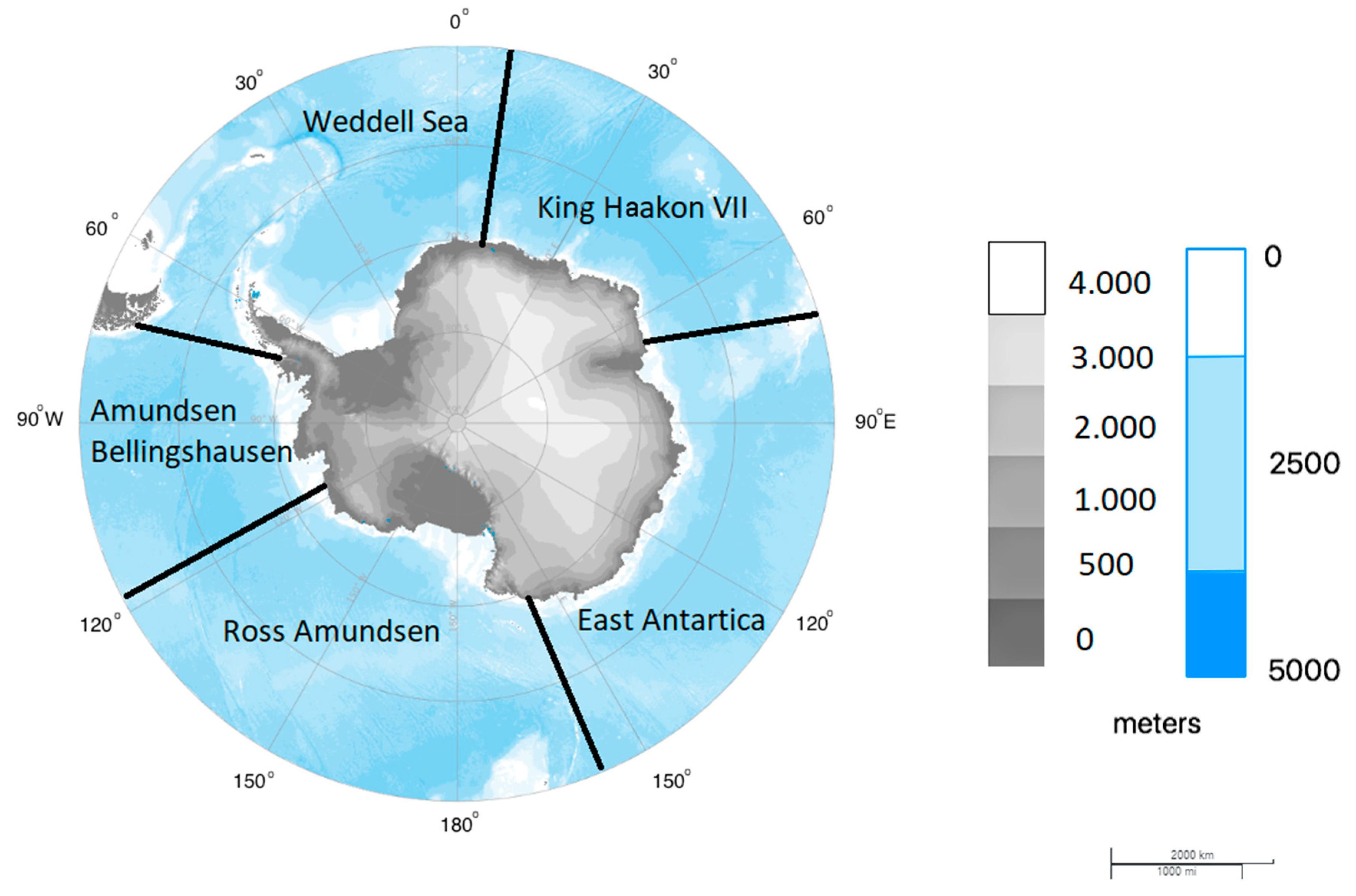
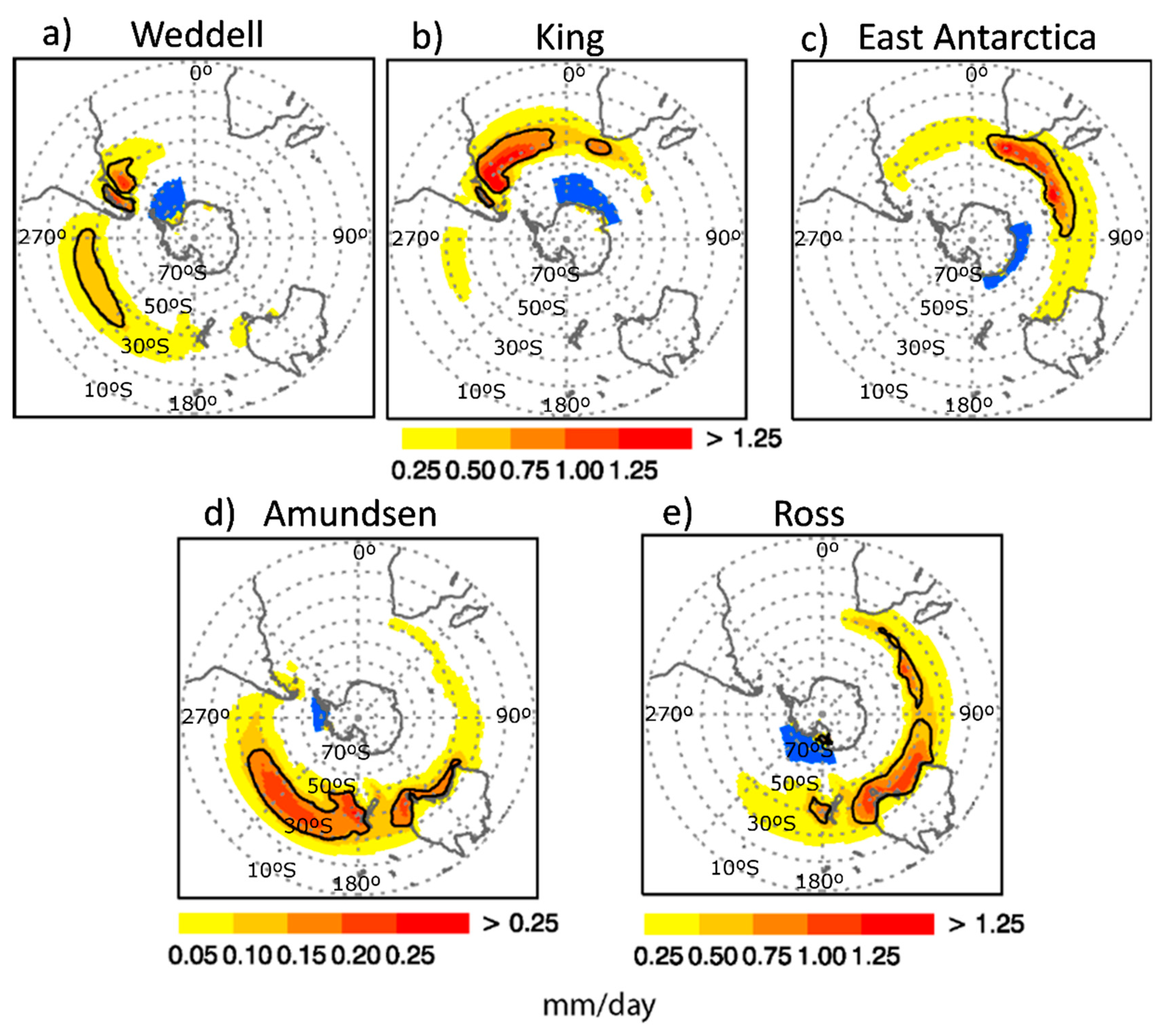
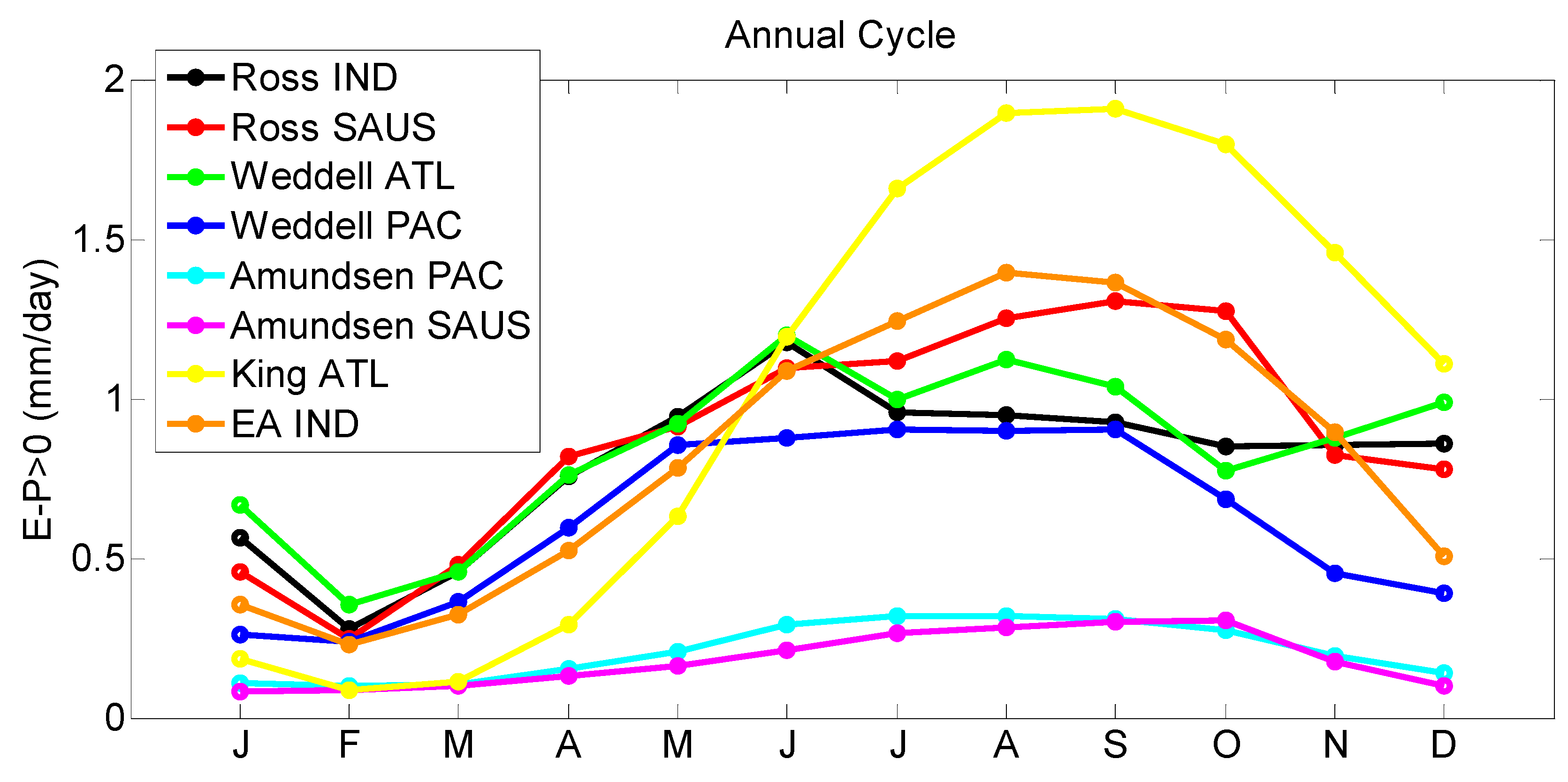
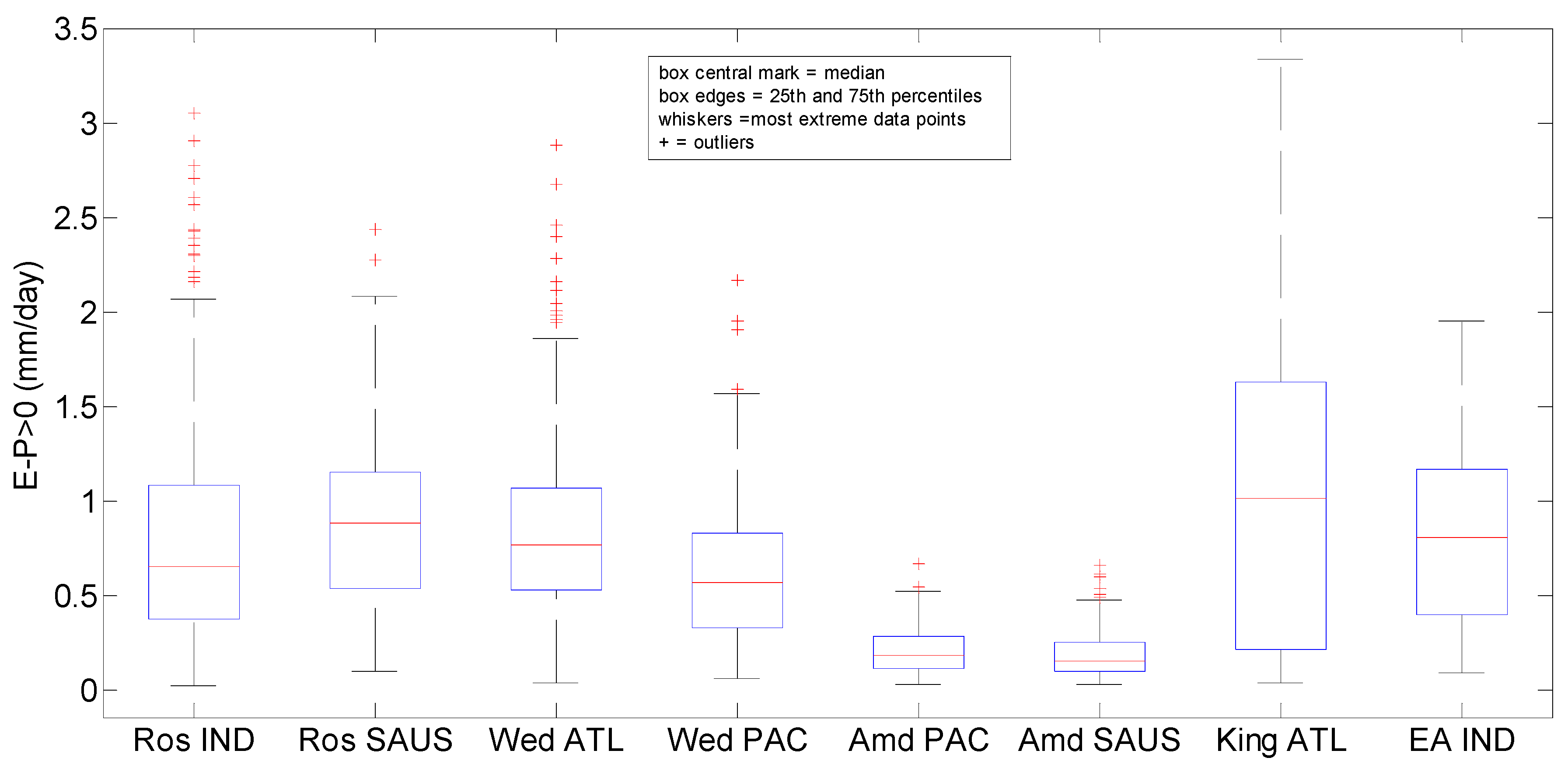

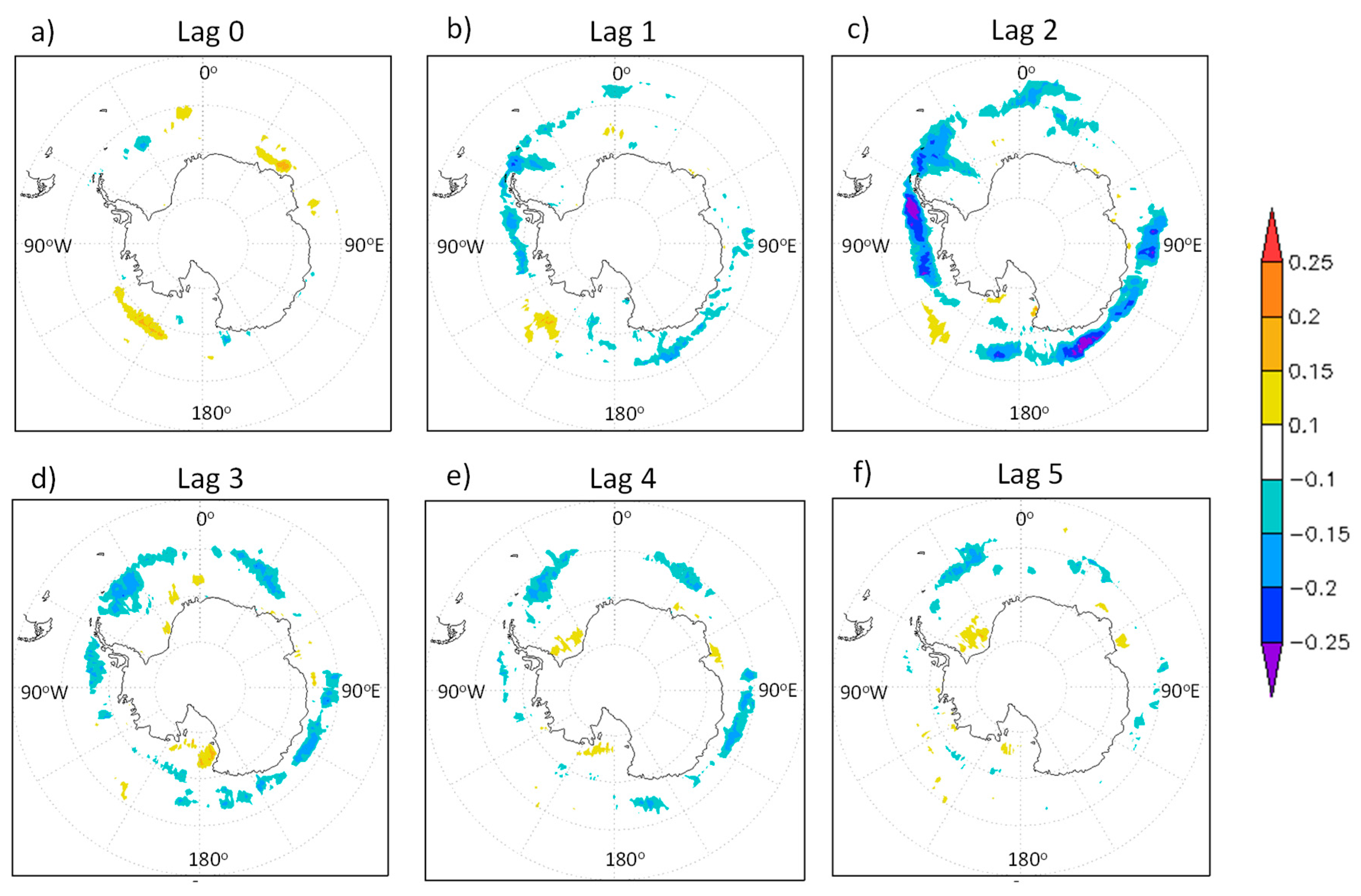

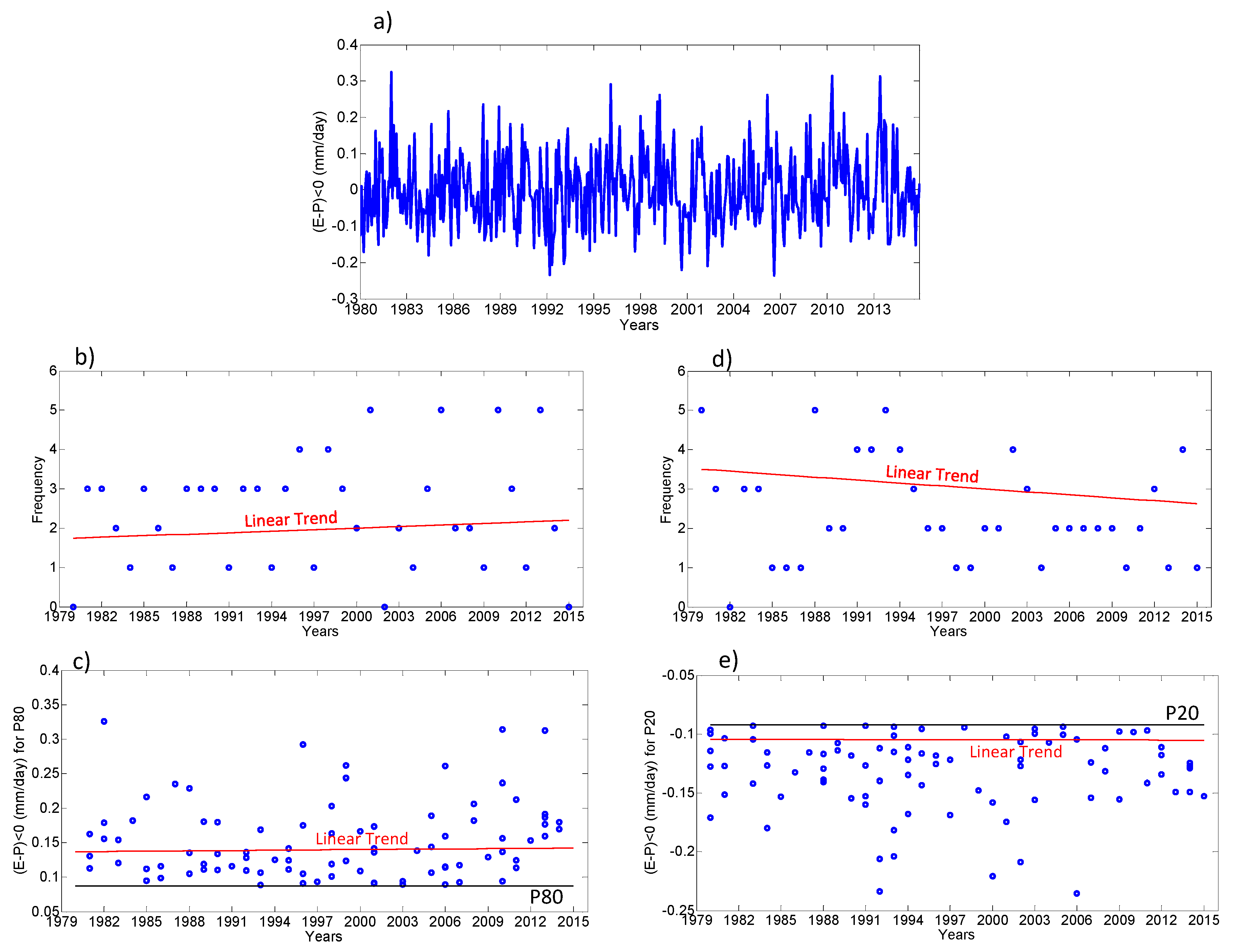
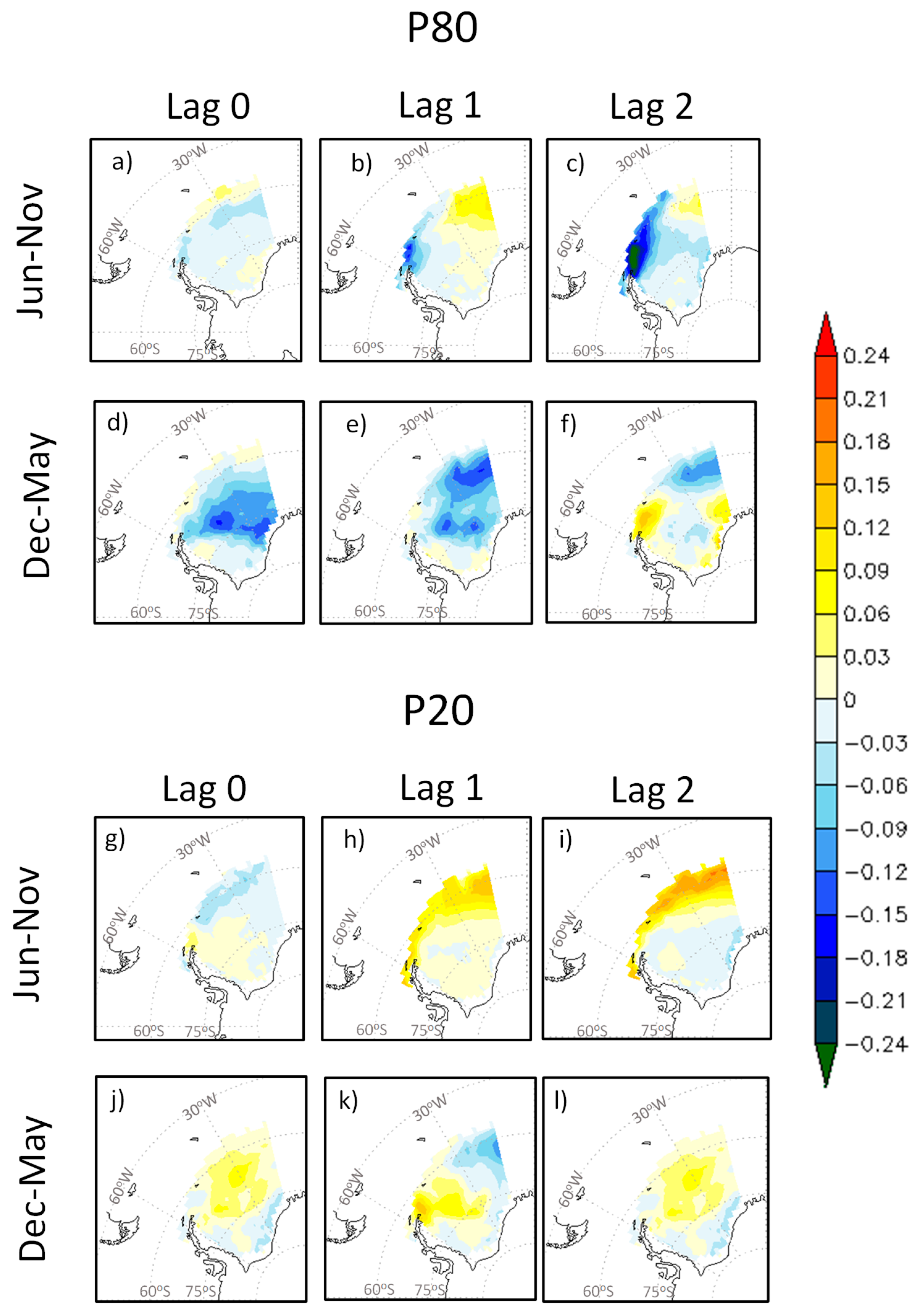
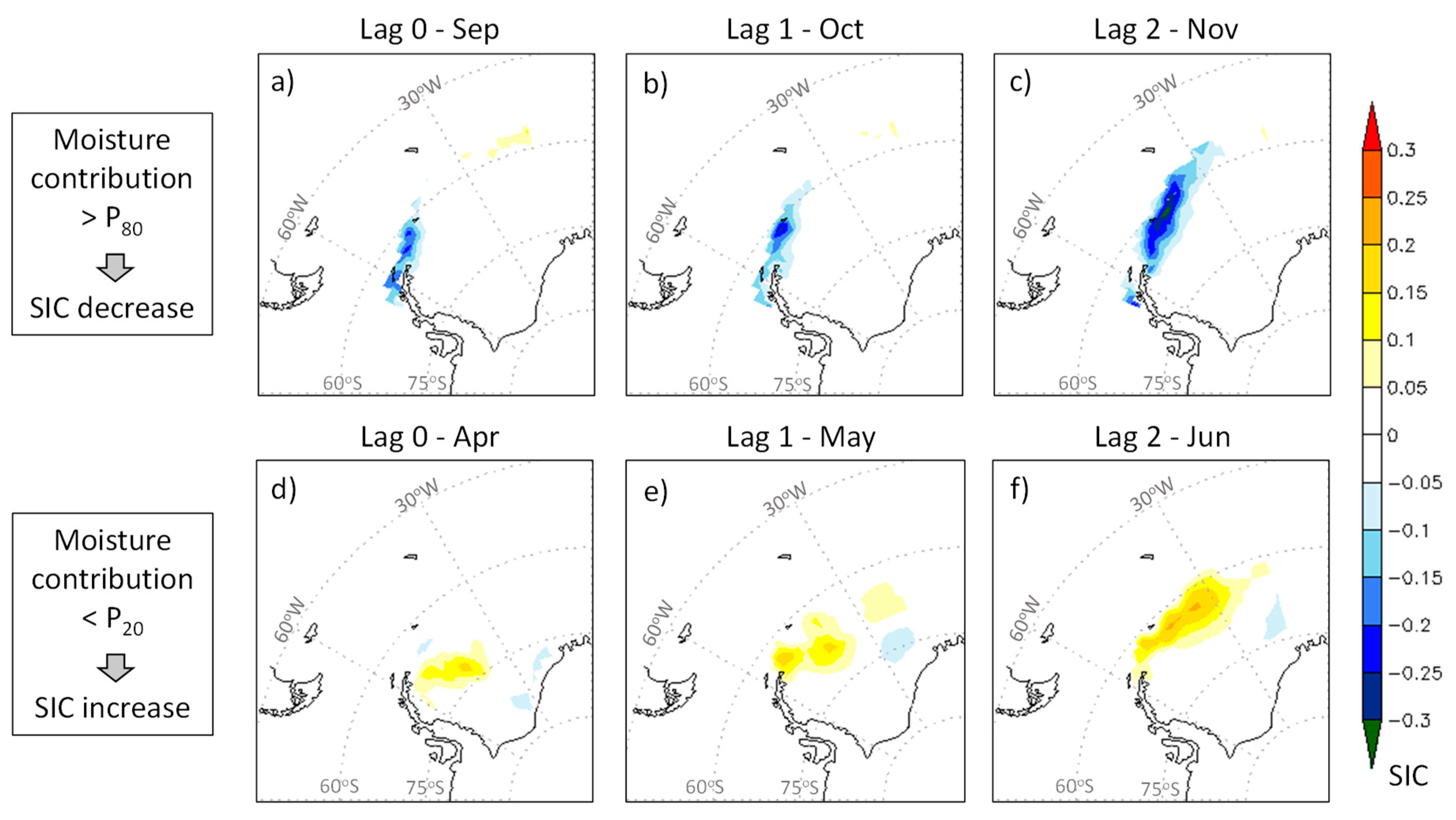
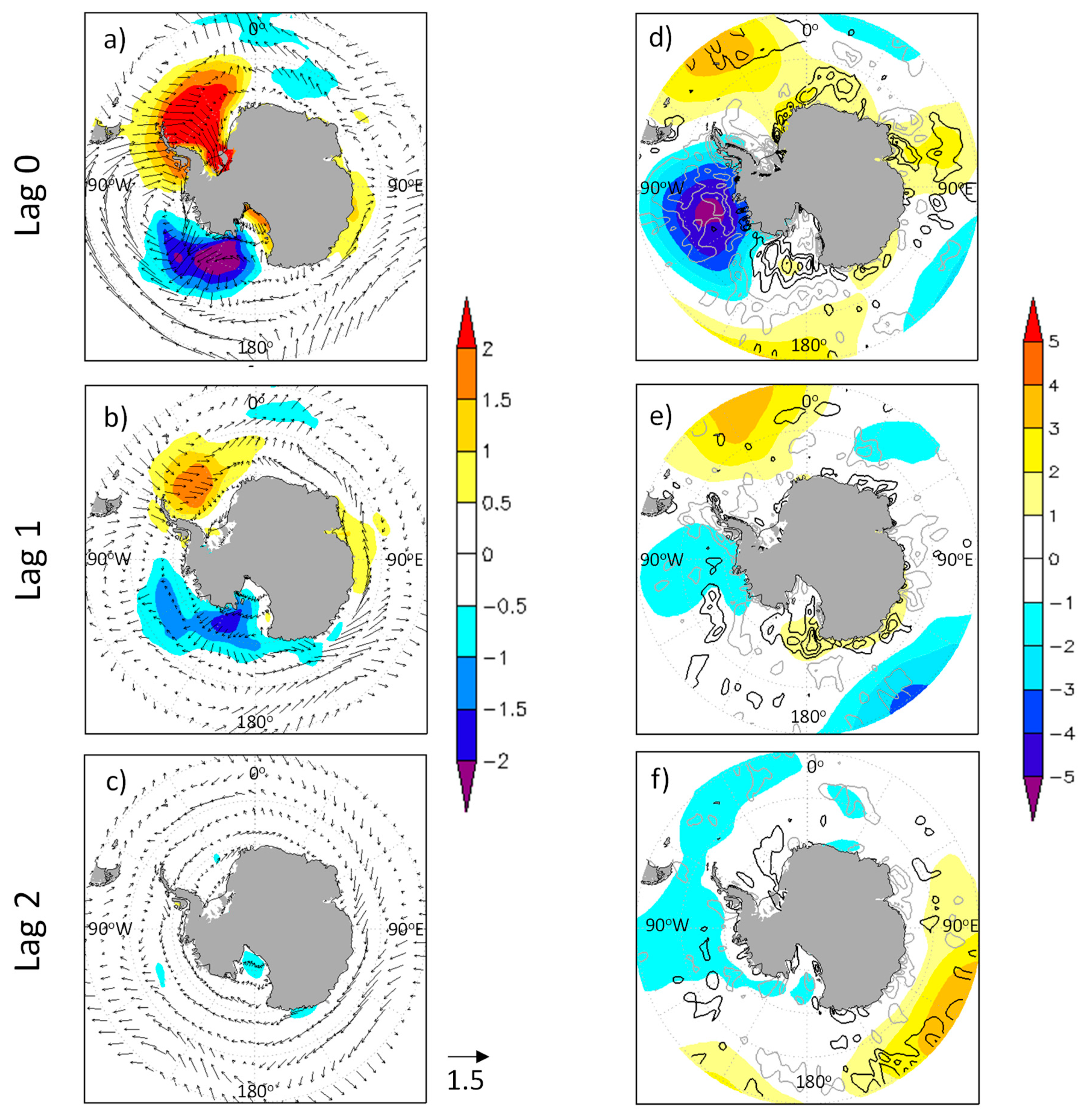
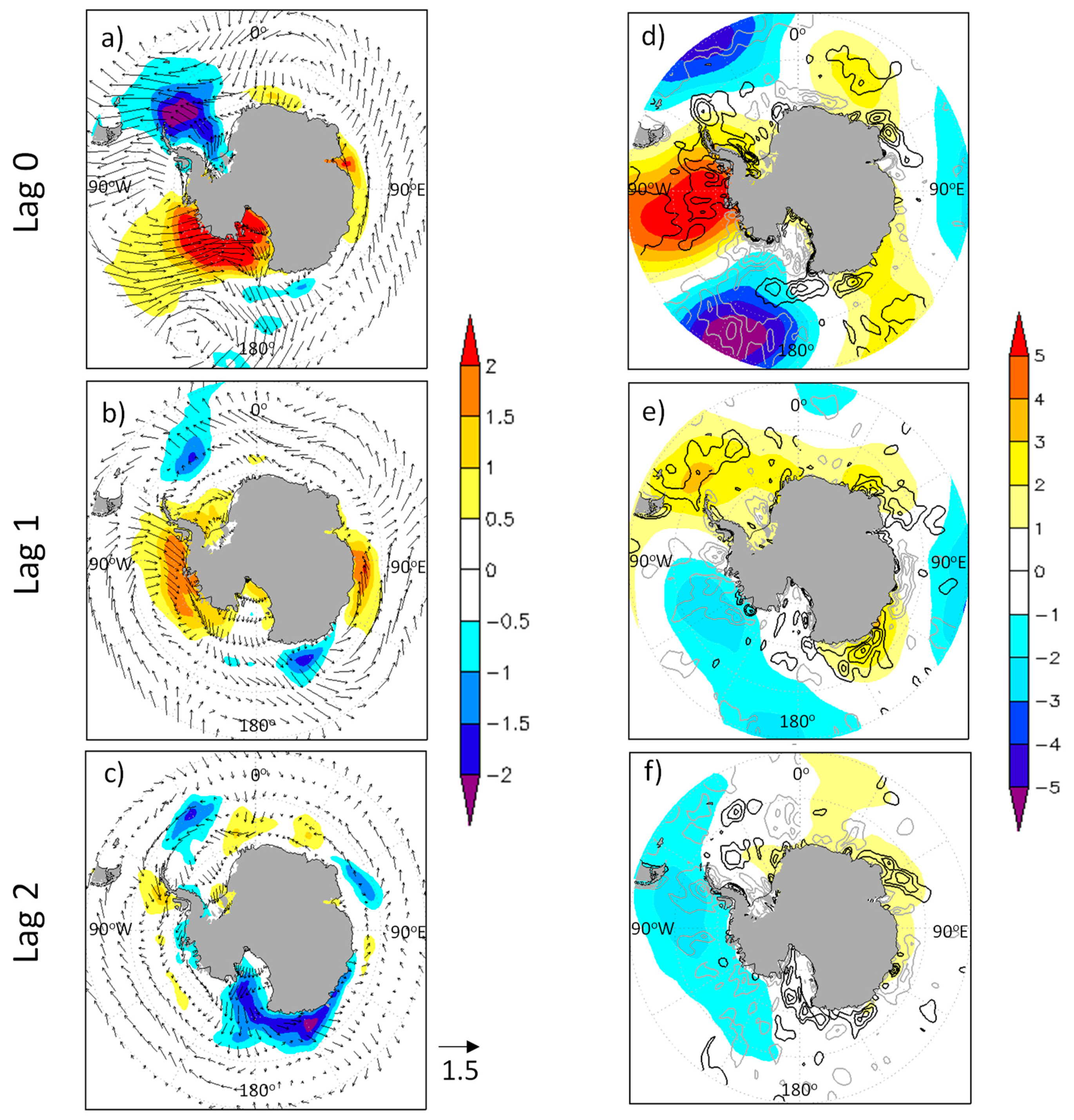
| Lags | Weddell Sea | King Haakon VII Sea | East Antarctica Sea | Amundsen Sea | Ross Sea |
|---|---|---|---|---|---|
| lag-0 | −0.092 | 0.060 | −0.070 | −0.031 | 0.075 |
| lag-1 | −0.198 | −0.035 | −0.112 | −0.176 | −0.008 |
| lag-2 | −0.311 | −0.127 | −0.212 | −0.281 | −0.121 |
| lag-3 | −0.240 | −0.086 | −0.107 | −0.126 | −0.141 |
| lag-4 | −0.168 | −0.062 | −0.126 | −0.088 | −0.166 |
| lag-5 | −0.084 | −0.045 | −0.025 | −0.077 | −0.105 |
| lag-6 | −0.045 | 0.018 | −0.027 | −0.056 | −0.056 |
| Austral Seas | Moisture | SIC |
|---|---|---|
| Weddell | 0.0004 | 0.0014 |
| King Haakon VII | 0.0014 | 0.0015 |
| East Antarctica | −0.0004 | 0.0016 |
| Amundsen | −0.0006 | −0.0012 |
| Ross | 0 | 0.0016 |
| Periods | Southern Annular Mode (SAM) | |
|---|---|---|
| SAM + | SAM - | |
| P20 December–May | 16 (35%) | 30 (65%) |
| P20 June–November | 9 (22%) | 31 (78%) |
| P80 December–May | 33 (79%) | 9 (21%) |
| P80 June–November | 28 (64%) | 16 (36%) |
© 2019 by the authors. Licensee MDPI, Basel, Switzerland. This article is an open access article distributed under the terms and conditions of the Creative Commons Attribution (CC BY) license (http://creativecommons.org/licenses/by/4.0/).
Share and Cite
Reboita, M.S.; Nieto, R.; da Rocha, R.P.; Drumond, A.; Vázquez, M.; Gimeno, L. Characterization of Moisture Sources for Austral Seas and Relationship with Sea Ice Concentration. Atmosphere 2019, 10, 627. https://doi.org/10.3390/atmos10100627
Reboita MS, Nieto R, da Rocha RP, Drumond A, Vázquez M, Gimeno L. Characterization of Moisture Sources for Austral Seas and Relationship with Sea Ice Concentration. Atmosphere. 2019; 10(10):627. https://doi.org/10.3390/atmos10100627
Chicago/Turabian StyleReboita, Michelle Simões, Raquel Nieto, Rosmeri P. da Rocha, Anita Drumond, Marta Vázquez, and Luis Gimeno. 2019. "Characterization of Moisture Sources for Austral Seas and Relationship with Sea Ice Concentration" Atmosphere 10, no. 10: 627. https://doi.org/10.3390/atmos10100627
APA StyleReboita, M. S., Nieto, R., da Rocha, R. P., Drumond, A., Vázquez, M., & Gimeno, L. (2019). Characterization of Moisture Sources for Austral Seas and Relationship with Sea Ice Concentration. Atmosphere, 10(10), 627. https://doi.org/10.3390/atmos10100627









